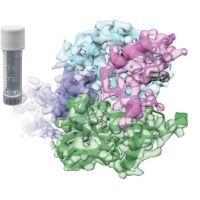Specification
| Description | Recombinant protein from the full-length sequence of Homo sapiens nuclear receptor subfamily 1 group I member 3 (NR1I3), transcript variant 1 (NM_001077482). |
| Organism | Homo sapiens (Human) |
| Expression Host | Human Cells |
| Tag Info | His or DYKDDDDK. Please contact us if you need further information or require specific designed tag. |
| Purity | Greater than 90% by SDS-PAGE gel |
| Uniprot ID | Q14994 |
| Entry Name | NR1I3_HUMAN |
| Gene Names | NR1I3 CAR |
| Alternative Gene Names | CAR |
| Alternative Protein Names | Nuclear receptor subfamily 1 group I member 3 (Constitutive activator of retinoid response) (Constitutive active response) (Constitutive androstane receptor) (CAR) (Orphan nuclear receptor MB67) |
| Application | Antigens, Western, ELISA and other in vitro binding or in vivo functional assays, and protein-protein interaction studies; For research & development use only! |
| Buffer | Purified protein formulated in a sterile solution of PBS buffer, pH7.2, without any preservatives |
| Endotoxin | Endotoxin level is < 0.1 ng/µg of protein (<1EU /µg) |
| Length | 352 |
| Molecular Weight(Da) | 39942 |
| Protein Sequence | (The sequence of expressed protein may have some variation from the sequence shown below. Please contact us for the exact sequence.) MASREDELRNCVVCGDQATGYHFNALTCEGCKGFFRRTVSKSIGPTCPFAGSCEVSKTQRRHCPACRLQKCLDAGMRKDMILSAEALALRRAKQAQRRAQQTPVQLSKEQEELIRTLLGAHTRHMGTMFEQFVQFRPPAHLFIHHQPLPTLAPVLPLVTHFADINTFMVLQVIKFTKDLPVFRSLPIEDQISLLKGAAVEICHIVLNTTFCLQTQNFLCGPLRYTIEDGARVSPTVGFQVEFLELLFHFHGTLRKLQLQEPEYVLLAAMALFSPDRPGVTQRDEIDQLQEEMALTLQSYIKGQQRRPRDRFLYAKLLGLLAELRSINEAYGYQIQHIQGLSAMMPLLQEICS |
Background
| Function | FUNCTION: Binds and transactivates the retinoic acid response elements that control expression of the retinoic acid receptor beta 2 and alcohol dehydrogenase 3 genes. Transactivates both the phenobarbital responsive element module of the human CYP2B6 gene and the CYP3A4 xenobiotic response element. |
| Pathway | |
| Protein Families | Nuclear hormone receptor family, NR1 subfamily |
| Tissue Specificity | Predominantly expressed in liver. |
QC Data
| Note | Please contact us for QC Data |
| Product Image (Reference Only) |  |

